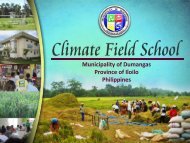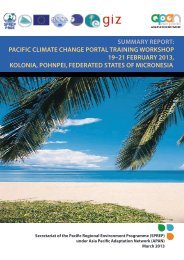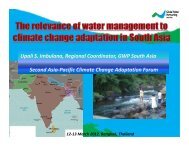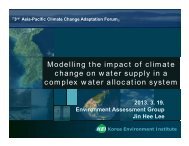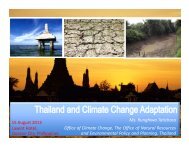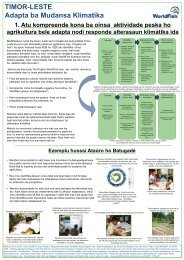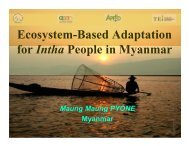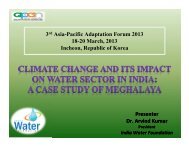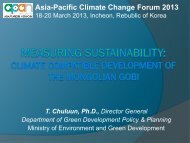PDF file (2.44 MB) - Asia Pacific Adaptation Network
PDF file (2.44 MB) - Asia Pacific Adaptation Network
PDF file (2.44 MB) - Asia Pacific Adaptation Network
Create successful ePaper yourself
Turn your PDF publications into a flip-book with our unique Google optimized e-Paper software.
48Parallel Sessions 4: Systems and Tools for Analysing Climate Change Impacts and VulnerabilityoExcessive nutrients in the lake, usually due to nutrient runoffs from animal waste,fertilisers, and sewage (pollution) from the land cause a dense growth of plant life,manifested as greenish water (berdeng tubig). The decomposing plants deplete theoxygen supply, leading to fish kills.Causal diagram of Taal Lake fish killQ: How will the obtained data be used?A: The project is still looking at the range of possible predictors for fish kill. If those factors are properlyidentified, they will be used as parameters of the model we are developing.Q: How does the predictive fish kill model work?A: The data (parameters, predictors, etc.) from different sources are integrated into a single frameworkthat “computes” for the probability of a fish kill event so we can give an early warning as needed.Q: What can the community do if you already have an early warning system?A: A centralized computer system at the provincial office will be networked to the fishing communitiesso that people will be informed of the lake condition in real time. In case of a predicted fish killoccurrence, they could take necessary precautions to lessen their losses. For instance, they maymove their fish cages to portions of the lake that will not be affected, or otherwise harvest their fishearlier than scheduled.Additional comment: The simulations will have a seven-day leeway before the predicted fish kill event forclimate-related causes. Lead time for hydrothermal events or sulfur upwelling (from the active volcano inthe middle of Taal Lake) is an extremely short two hours.International Conference on Climate Change Impactsand <strong>Adaptation</strong> for Food and Environmental SecurityConference Summary Report




